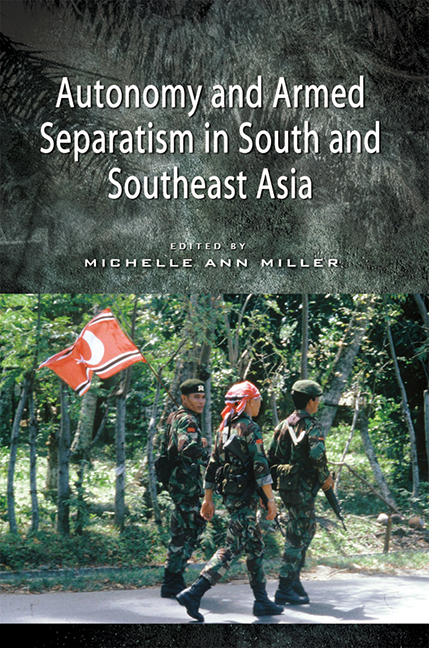Book contents
- Frontmatter
- Dedication
- Contents
- Acknowledgements
- About the Contributors
- 1 The Problem of Armed Separatism: Is Autonomy the Answer?
- 2 Mediated Constitutionality as a Solution to Separatism
- 3 Self-Governance as a Framework for Conflict Resolution in Aceh
- 4 Autonomy and Armed Separatism in Papua: Why the Cendrawasih Continues to Fear the Garuda
- 5 The Parallels and the Paradox of Timor-Leste and Western Sahara
- 6 Between Violence and Negotiation: Rethinking the Indonesian Occupation and the East Timorese Resistance
- 7 Struggle over Space in Myanmar: Expanding State Territoriality after the Kachin Ceasefire
- 8 Sri Lanka's Ethnic Conflict: The Autonomy-Separation Dialectic
- 9 Unitarianism, Separatism and Federalism: Competing Goals and Problems of Compromise in Sri Lanka
- 10 Autonomy and Armed Separatism in Jammu and Kashmir
- 11 Armed Conflicts and Movements for Autonomy in India's Northeast
- 12 Southern Thailand: The Trouble with Autonomy
- 13 The Last Holdout of an Integrated State: A Century of Resistance to State Penetration in Southern Thailand
- 14 Interlocking Autonomy: Manila and Muslim Mindanao
- 15 History, Demography and Factionalism: Obstacles to Conflict Resolution through Autonomy in the Southern Philippines
- 16 Conclusion
- Index
12 - Southern Thailand: The Trouble with Autonomy
Published online by Cambridge University Press: 21 October 2015
- Frontmatter
- Dedication
- Contents
- Acknowledgements
- About the Contributors
- 1 The Problem of Armed Separatism: Is Autonomy the Answer?
- 2 Mediated Constitutionality as a Solution to Separatism
- 3 Self-Governance as a Framework for Conflict Resolution in Aceh
- 4 Autonomy and Armed Separatism in Papua: Why the Cendrawasih Continues to Fear the Garuda
- 5 The Parallels and the Paradox of Timor-Leste and Western Sahara
- 6 Between Violence and Negotiation: Rethinking the Indonesian Occupation and the East Timorese Resistance
- 7 Struggle over Space in Myanmar: Expanding State Territoriality after the Kachin Ceasefire
- 8 Sri Lanka's Ethnic Conflict: The Autonomy-Separation Dialectic
- 9 Unitarianism, Separatism and Federalism: Competing Goals and Problems of Compromise in Sri Lanka
- 10 Autonomy and Armed Separatism in Jammu and Kashmir
- 11 Armed Conflicts and Movements for Autonomy in India's Northeast
- 12 Southern Thailand: The Trouble with Autonomy
- 13 The Last Holdout of an Integrated State: A Century of Resistance to State Penetration in Southern Thailand
- 14 Interlocking Autonomy: Manila and Muslim Mindanao
- 15 History, Demography and Factionalism: Obstacles to Conflict Resolution through Autonomy in the Southern Philippines
- 16 Conclusion
- Index
Summary
To the casual observer, the Southern Thai conflict looks like a classic case of autonomy waiting to happen. A minority population is conveniently located close to one of the country's borders; and assimilation policies have been incompletely successful, leaving residues of bitterness, resentment and violence. Rather than continue to run the minority region from Bangkok, why not simply give the Malay Muslims of the far South some form of autonomy? Why would a solution that seems to have “worked” (or at least to have reduced violence and improved matters greatly) in comparable conflicts ranging from Northern Ireland to Aceh not be worth exploring in the context of Southern Thailand? Unfortunately, it is not quite that simple.
Thailand's national identity, summarized in the ubiquitous shibboleth “Nation, Religion, King”, is predicated upon a set of national myths about the country's origins. These include a belief that Siam was never colonized; that colonization was averted through the genius of King Chulalongkorn and the Chakri dynasty; and that Siam successfully adopted various features of a modern western nation, in order to demonstrate a high level of “civilization” that would provide a vaccine against colonization. The models adopted by Siam were those of the two dominant colonial powers in Southeast Asia, Britain and France, both unitary states. In expanding Bangkok's territorial reach to include Lao, Khmer and Malay populations, Siam consistently favoured assimilation and centralization over federalist alternatives. Over time, traditional rulers were replaced by career bureaucrats appointed from Bangkok, in a process often dubbed “internal colonialism”.
While leading civilian statesman Pridi Phanomyong did advance alternative ideas for governing Thailand (as the nation became) during the period following the 1932 end of absolute monarchy, by the 1950s Pridi was in exile, and the Chakri dynasty was once more in the ascendant. The long reign of King Bhumibol Adulyadej (since 1946) has seen the collapse of the communist threat in Thailand, remarkable economic growth, and the emergence of a more democratic politics. For most Thais, King Bhumibol deserves immense personal credit for guiding Thailand through an extraordinary period of transformation.
- Type
- Chapter
- Information
- Autonomy and Armed Separatism in South and Southeast Asia , pp. 217 - 234Publisher: ISEAS–Yusof Ishak InstitutePrint publication year: 2012

